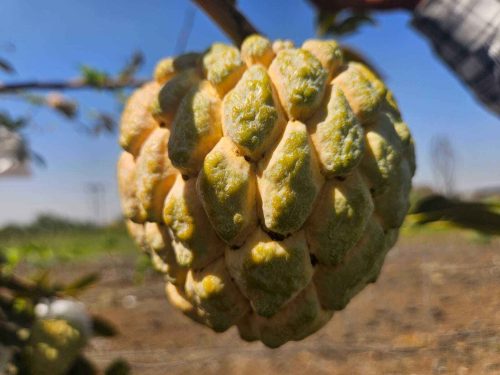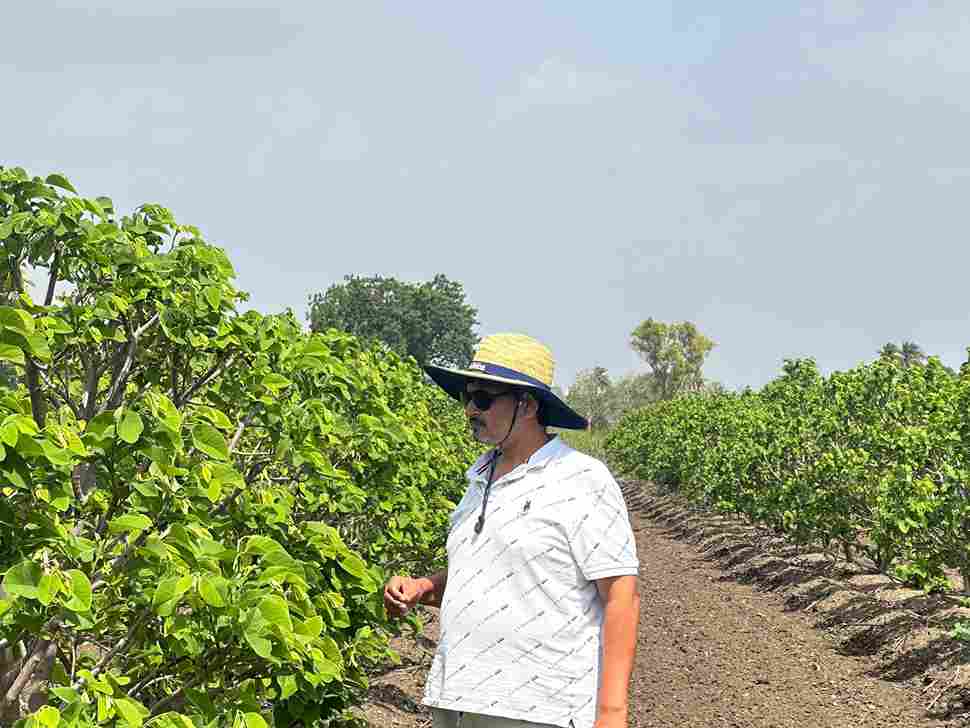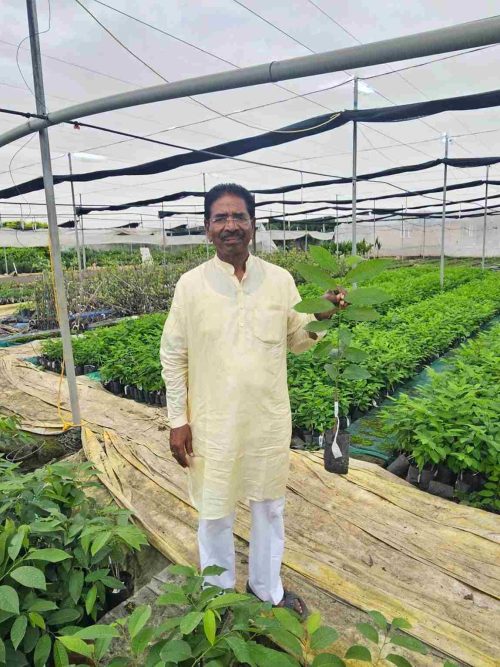Solapur Farmer’s Golden Sitaphal Brings Rs 12 Lakh/Hectare, Benefits 140 Villages in Maharashtra Alone
Ever heard of gaining high yields of a fruit variety in dry regions?
A major portion of Maharashtra and Madhya Pradesh is drought-prone, and to everyone’s surprise, there is one fruit variety that flourishes in these conditions. It is called NMK-01 (Golden), popularly known as Golden Sitaphal (Custard Apple).
NMK-01 (Golden) is cultivated in 16 Indian states and even in Tanzania, especially in dryland zones. Maharashtra, particularly drought-prone districts like Solapur, Beed, Aurangabad, and Parbhani, has seen widespread adoption of this variety—followed by Madhya Pradesh.
Farmers also praise its high yields, which can go up to 10 tonnes per acre.
But who developed the Golden Sitaphal?
The Better India sat down with 67-year-old farmer innovator Navnath Kaspate, the mind behind this unique variety. In 2019, his innovation earned him Intellectual Property Rights from the Protection of Plant Varieties and Farmers’ Rights Authority (PPV&RA). Today, he owns a 70-acre farm—Madhuban Farm and Nursery—which is home to 42 different varieties of custard apples.
Tracing the history of Golden Sitaphal
Belonging to the Annonaceae family, custard apple—heart-shaped, spherical, or irregular—features quilted skin that turns brown as it ripens. Originally from South America and the West Indies, Sitaphal was introduced to India by the Portuguese in the 16th century.
Remarkably, depictions of custard apples appear in ancient Indian sculptures, such as those at Bharhut, Sanchi, Ajanta, and Mathura, dating back to the 2nd century BCE.
While varieties like Balanagar, Phule Purandhar, and Lal Sitaphal exist, NMK-01 (Golden) is expanding rapidly due to its strong market acceptance and profitability for farmers.
Started by one innovator, many followed suit
As a dryland crop, custard apple requires minimal irrigation—especially in the first two years—and is well-suited for drip irrigation, resulting in fewer pest attacks.
 Many farmers and experts praise NMK-01 (Golden) for its high yield, larger fruit size, fewer seeds, and better market prices.
Many farmers and experts praise NMK-01 (Golden) for its high yield, larger fruit size, fewer seeds, and better market prices.
Kaspate shares, “I used to grow grapes and ber, but after developing NMK-01, I converted my entire farm to Sitaphal, inspiring others to follow.” Farmers in five talukas—Barshi, Khamgaon, Ghormale, Kasarwadi, and Wanewadi—took to the charm of custard apple.
In Barshi taluka alone, 140 villages now cultivate custard apple.
Why Is NMK-01 Golden Sitaphal the most preferred variety?
Of the 173 accepted Annona species worldwide, Kaspate’s 70-acre Madhuban Farm and Nursery is like a living museum. You can find Annona glabra, Pink’s Mammoth, Annona muricata, Icecal, Washington Jem, Annona montana, and many more on his farm.
His farm is the country’s largest nursery devoted to Sitaphal and also serves as a development and research centre. Additionally, he hosts prospective custard apple growers with free full-day workshops on agronomic practices.
“I have created around 3,000 varieties using the process of cross-pollination. These cannot be found elsewhere. Only when one registers a variety with an authority like the PPV & Farmers’ Rights Authority (FRA), can it be officially recognised. I have selected some of them, filed for patents, and started acquiring Intellectual Property Rights (IPR). In India, living things like plants and animals, and the natural processes used to produce them, can’t be patented—but they can receive other forms of IPR protection,” he explains.
Solapur’s Krishi Vigyan Kendra highlights several of his innovative custard apple varieties: Annona-2, NMK-1, NMK-2, NMK-3, and Finger Prints.
One of Kaspate’s most popular varieties is NMK-1, which he began developing in 2002. Farmers love it for its attractive colour and size, the good number of fruits each plant produces, and its uniform shape—making it ideal for export. The fruits also stay unripe on the plant for 20–25 days, don’t crack after harvesting, and suffer fewer losses during transport.
Comparing varieties: market research, pricing, yield, taste, and farmer preference
Maharashtra leads custard apple production in India, with other popular varieties like Lal Sitaphal, Balanagari, and Phule Purandhar also grown here.
Out of the 55,000 hectares of custard apple farms in India, 7,000 hectares are in Maharashtra alone.
Custard apples are traded daily in and outside the state, with supplies reaching markets in Mumbai, Pune, Hyderabad, Bengaluru, and Delhi. From market yards in Pune and Navi Mumbai, the creamy, grainy-fleshed fruit is distributed to fruit stalls and malls in major cities across the country.
Compared to Balanagar and Phule Purandhar, NMK-01 yields up to 12 tonnes per acre (versus five to six tonnes) and commands a higher price. However, while its appearance and sweetness appeal to many, some growers and consumers find its flavour less desirable than local varieties.
 Maharashtra leads custard apple production in India, with other popular varieties like Lal Sitaphal, Balanagari, and Phule Purandhar.
Maharashtra leads custard apple production in India, with other popular varieties like Lal Sitaphal, Balanagari, and Phule Purandhar.
NMK-01 is sweeter and visually attractive, but several people describe its taste as different or less appealing—possibly due to its hybrid origin with Atemoya.
Many farmers and experts praise NMK-01 (Golden) for its high yield, larger fruit size, fewer seeds, and better market prices. Reports show that this variety can double production and significantly increase income, with some farmers earning up to Rs 12 lakh per hectare and market prices reaching Rs 200 to Rs 300 per kg.
About six years ago, 35-year-old Ravi Dabhade from Jerai village in Maharashtra’s Beed district planted around 6,000 NMK-01 custard apple saplings across 12 acres of land.
Encouraged by the success, he expanded cultivation by another four acres a few years later. Today, his orchard spans nearly 20 acres, yielding an impressive seven tonnes per acre.
 Kaspate shares, “I used to grow grapes and ber, but after developing NMK-01, I converted my entire farm to Sitaphal, inspiring others to follow.”
Kaspate shares, “I used to grow grapes and ber, but after developing NMK-01, I converted my entire farm to Sitaphal, inspiring others to follow.”
Ravi attributes his high productivity to disciplined crop management, especially eight annual foliar sprays that keep pests away.
Meanwhile, in 2018, 55-year-old Dinesh Patidar from Jamli village in Mhow Cantonment, Madhya Pradesh, planted 4,800 saplings sourced from Madhuban across 12 acres.
“I grow a mix of fruits like mango, dragon fruit, guava, and avocado. Sitaphal starts bearing fruit in October, and the harvest continues through mid-January. I typically get four to five tonnes per acre, bringing in a profit of around Rs 1.5 lakh per acre,” he explains.
New varieties and the road ahead
Kaspate shares, “It has taken me close to 12 years to develop the new varieties—NMK Arvi and NMK Samruddhi. Arvi is a cross between NMK-01 (Golden) and Lal Sitaphal, while the red-coloured Samruddhi is a mix of Sitaphal and Ramphal (Annona reticulata). Both are harvested in February.”
He adds, “Since December 2021, NMK Samruddhi has been tested over six harvests. On average, each fruit weighed 350 grams, had 60% pulp, and a sweetness level (Brix) of 25—making it a favourite among both farmers and buyers. NMK Arvi also showed similar results, with 350-gram fruits, 55% pulp, fewer seeds, and the same sweetness.”
Kaspate has distributed saplings for trials to farmers in Ghormale and Barshi talukas and plans to launch the new varieties once he secures IPR.
“I submitted the documents about the newly developed varieties to PPV&RA in November 2023. I will introduce them to farmers soon,” he says.
The challenge of counterfeiting
While working on new varieties, Kaspate continues to battle counterfeiters—a major challenge for farmer-innovators in India. Many nurseries sell unauthorised saplings under different names to hide their origin, but they are all NMK-01 (Golden), for which Kaspate holds the IPR.
He has filed cases in the Solapur District Court against 220 nurseries for selling counterfeits and has paid Rs 15 lakhs in stamp duty for the same.
With every breakthrough, Kaspate not only uplifts his community but redefines what it means to farm with purpose in dryland India.
All images courtesy Hiren Bose
News